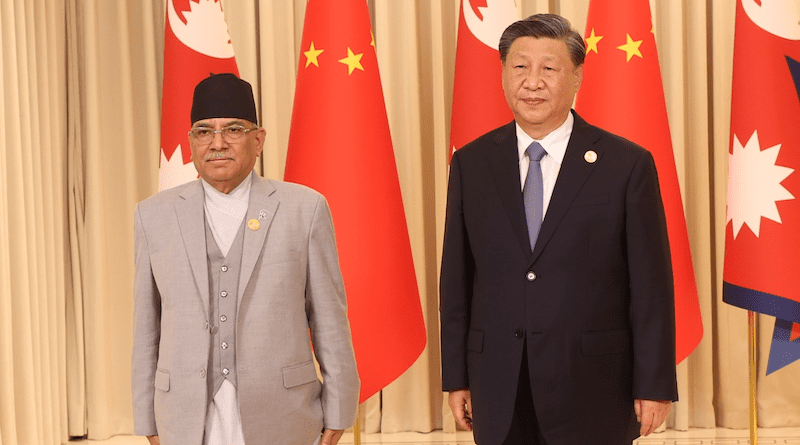BRI To Nepal: East India Company To India – OpEd
By Patial RC
In the year of the Dragon, the Chinese Dragon is entersing into Nepal through the Belt and Road Initiative (BRI). This belt of road infrastructure will tighten the belt along Nepal’s length from West to East. So the Chinese Dragon is all set to strangle Nepal’s economy.
The East India Company (EIC) was founded in the year 1600 as a trading company. With a massive private army and the backing of the British government, the EIC looted the Indian subcontinent. The EIC was the means by which Britain conducted its imperialistic policies in Asia, and it made millions through its global trade in spices, tea, textiles, and opium. India, in contrast, became ever poorer. India’s share of world GDP was 24.4% in 1700 before British rule but fell to 4.2% by 1950. Tharoor says, “The reason was simple. India was governed for the benefit of Britain.” Britain’s rise for 200 years was financed by its loot from India.
The Rastriya Ekta Abhiyan organised an awareness rally in Pokhara, highlighting apprehensions about the BRI and its potential consequences for Nepal. The focal point of the protest was the Pokhara International Airport. While the airport was not officially part of the BRI, Chinese banks provided most of the funds, and a Chinese firm constructed the infrastructure. Beijing insisted that the project was part of the BRI despite reservations by Kathmandu. The group alleged that there might be ulterior motives, including the potential deployment of the Chinese army in Pokhara, using economic losses at the airport as a pretext.
BRI Project
The flagship BRI project in Nepal is the Trans-Himalayan Multi-Dimensional Connectivity Network (THMCN), which includes a cross-border railway connecting China’s Tibet Autonomous Region with Nepal’s capital, Kathmandu. A further extension to Pokhara and Lumbini was also discussed in 2018.
The China-Nepal Friendship Industrial Park (also known as Damak Clean Industrial Park) in Jhapa. The first phase plans to develop, over a period of three years, an area of 424.81 hectares, including 133.33 hectares of core area, with an estimated investment of US$586 million. A total of 192 small, medium, and large factories are expected to be set up inside the industrial park in the first phase.
Delays from Nepal
So far engineering difficulties due to the gradient terrain from the Tibetan Plateau to the low Nepal valleys, daunting costs, and geopolitical factors have prevented this rail connection from materializing. Critics have also mentioned that successive Nepal governments have failed to maintain the conditions of existing highway routes to Kodari and Rasuwagadi to international standards.
Nepal rail infrastructure. While delays have plagued the development of necessary Nepal rail infrastructure, steady progress has been achieved on the China-Tibet side. In June 2021, China inaugurated the 435 km section of the Lhasa-Nyingchi Electrified High-speed Rail (HSR), which passes through 47 tunnels and 121 bridges along the Brahmaputra (Tsang Po) River. The bullet train is part of the new Sichuan-Tibet Railway. According to media reports, if this railway section gets “connected to Kerung via Lhasa and Shigatse, it would put Lhasa within six hours distance and Chengdu within 19 hours from the Nepal border”.
The China-Nepal Friendship Industrial Park. In the second phase it will develop 363.74 hectares and in the third phase 372.04 hectares. Living facilities will be improved simultaneously, to secure “industrial and urban symbiosis”. The fourth and final phase will see 436.21 hectares of land planned for commercial real estate development, science, education, research, and development industries, improving industrial structure, and establishing supporting facilities. The industrial park is projected to achieve US$5 billion output value at scale by 2030, employ 60,000 people, and house 100,000 permanent residents.
The BRI in Nepal remains a near non-starter. Nepal and China signed a memorandum of understanding on BRI in 2017. Nearly seven years since, not a single project under the initiative has either been executed as successive governments in Nepal have been averse to borrowing loans from Beijing unlike Sri Lanka, Pakistan and some African nations. Kathmandu has been keen to accept grants rather than Chinese loans which are extended at high interest rates. While there have been fears of the China’s debt trap economic diplomacy.
China’s BRI Debt Traps Economic Diplomacy
According to AidData report (March 27, 2023 demonstrates that, by the end of 2021, China had undertaken 128 rescue loan operations across 22 debtor countries worth $240 billion. These operations include many so-called “rollovers,” in which the same short-term loans are extended again and again to refinance maturing debts. The BRI has left countries drowning in huge debts, the IMF’s numerous lending programs for developing countries create those same “Debt Traps”.
There are growing signs of ‘Disenchantment’ among so called BRI aided countries. A large number of the BRI infrastructure projects have encountered major implementation problems like corruption scandals, quality, labour violations, environmental hazards, and public protests. Project suspensions and cancellations are on the rise.BRI Debt-Trap Diplomacy offers projects or loans on terms that end up being too difficult for countries to repay, eventually compelling them to accept political or economic concessions.
Through the BRI, China has cemented itself as an economic giant with the capability to lend massive amounts of capital to countries with high interest rates. China seemingly structures its lending programs and interest rates to entrap the borrowing country into a never-ending spiral of debt. Then when a country is not able to repay the loans, China takes over its economy creating further dependence.
Hope and wish our friendly neighbour Nepal has learned lessons from Sri Lanka, Pakistan, and some African nations that how they have got into these Chinese BRI Debt Traps Economic Diplomacy and take decisions in the long-term interests of the country and do not end up falling into the Chinese BRI Debt Traps.

